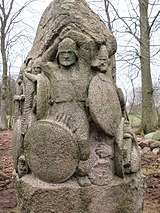Magnus the Good
| Magnus the Good | |
|---|---|
St. Olaf (Vestfold branch of Fairhair dynasty) | |
| Father | Olaf II of Norway |
| Mother | Alfhild |
Magnus Olafsson (
Magnus was an illegitimate son of King
Early life
Magnus was an illegitimate son of King
Olaf was dethroned by the Danish king
In early 1031, a party including Magnus's uncle
King of Norway and Denmark

Magnus was proclaimed king in 1035 at 11 years of age. At first, Magnus sought revenge against his father's enemies, but on Sigvatr's advice, he stopped doing so, which is why he became known as "good" or "noble".[9]
Another son of Cnut,
and who had some support.As part of consolidating his control, Magnus destroyed the
Sweyn continued to oppose Magnus in Denmark, although according to Heimskringla, they reached a settlement by which Sweyn became Earl of Denmark under Magnus.[18]
Magnus wanted to reunite Cnut the Great's entire North Sea Empire by also becoming king of England. When Harthacnut died, the English nobles had chosen as their king Æthelred the Unready's son Edward (later known as Edward the Confessor); Magnus wrote to him that he intended to attack England with combined Norwegian and Danish forces and "he will then govern it who wins the victory."[19] The English were mostly hostile to Magnus; Sweyn was made welcome there, although Edward's mother, Emma, curiously favored Magnus and in 1043 the king confiscated her property, with which by one report she had promised to assist Magnus.[20]
Meanwhile, Magnus' uncle Harald Sigurdsson had returned to Norway from the east and contested his rule there, while Sweyn was still a threat in Denmark; Harald allied himself with Sweyn.[1][14] Magnus chose to appease Harald,[1] and made him his co-king in Norway in 1046.[21][22]
Death

Sweyn increased the pressure on Magnus from his base in
Physical appearance
Heimskringla describes Magnus as "of middle height, with regular features and light complexion. He had light blond hair, was well spoken and quick to make up his mind, was of noble character, most generous, a great warrior, and most valorous."[25]
Descendants

The line of Olaf II ended with Magnus' death. However, in 1280, Eric II of Norway, who was descended through his mother from Magnus' legitimate sister, Wulfhild, was crowned king of Norway.
Magnus was not married, but had a daughter out of wedlock,
Notes
- ^ a b c d e f g Carl Frederik Bricka, Dansk Biografisk Lexikon, vol. XI [Maar – Müllner], 1897, p.44.
- ^ Morten (2011) p. 16
- ^ Morten (2011) p. 17
- ^ Morten (2011) pp. 15 & 18–20
- ^ Morten (2011) pp. 21–23
- ^ Morten (2011) pp. 25–27
- ISBN 9780198217169, pp. 405–06.
- ^ Morten (2011) pp. 28–29
- ^ OCLC 257284542, p. 110.
- ^ Morten (2011) pp. 40–44
- ^ a b Monarkiet i Danmark – Kongerækken Archived 18 November 2009 at the Wayback Machine at The Danish Monarchy
- ^ a b Larsen, p. 113.
- ^ OCLC 5954675, pp. 57–59.
- ^ Dansk biografisk lexikon, online at Project Runeberg(in Danish)
- .
- ^ Hollander (Trans.), Heimskringla, p. 562.
- ^ Hollander (Trans.), Heimskringla, p. 561.
- ^ Hollander (Trans.), Heimskringla, p. 558.
- ^ Larsen, p. 114.
- ^ Stenton, pp. 426–27.
- ^ Hollander (Trans.), Heimskringla, pp. 593–96.
- ^ Larsen, p. 111.
- ISBN 0-19-285063-6, p. 406.
- .
- ^ Hollander (Trans.), Heimskringla, p. 600.
Bibliography
- Morten, Øystein (2011). Magnus den gode. Sagakongene. Spartacus/Saga Bok. ISBN 978-82-430-0582-2.
Further reading
- Saga of Magnus the Good from Heimskringla, translated by Samuel Laing, online at the Medieval and Classical Literature Library.
- Heimskringla in Icelandic, Norwegian, and English, online at Idar Lind's "Norrøn Mytologi/Norrøn Tid."
- Saxo Grammaticus' Gesta Danorum, Book X chapters 21 and 22, online at Royal Danish Library.

